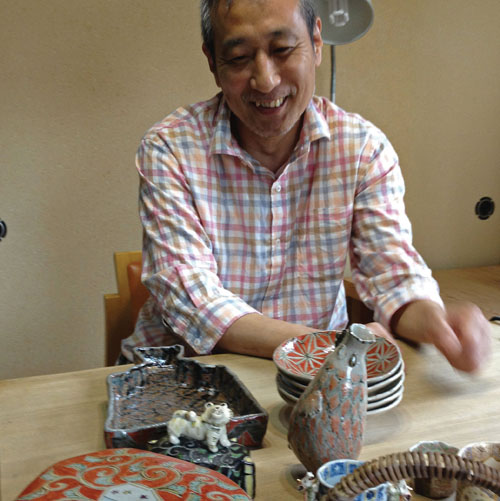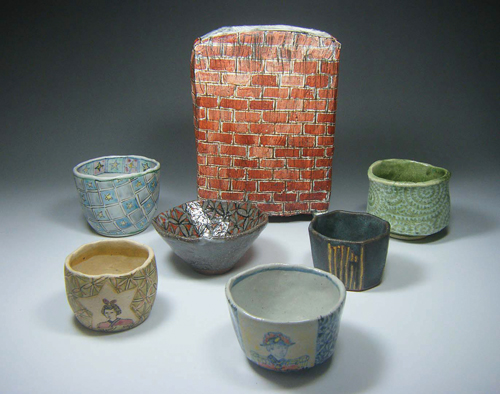Takiguchi Kazuo

|
Kyoto has always been the home of fancifully decorated ceramics since “The Three Great Masters” of Kyo-yaki (Kyoto pottery) Nonomura Ninsei (active in the Edo period, birth-death dates unknown) Ogata Kenzan (1663-1743), and Aoki Mokubei (1767-1833). Anyone walking up the slope to Kiyomizu Temple surely has seen shops full of such works all still under the influence of the ancient great trio. On the other hand, Kyoto is also the home of avant-garde ceramic sculptures dating to post WWII when the influential Sodeisha group was formed. The name means ‘crawling through the mud’, which was basically what aspiring ceramicists were doing at that time. Today we find Kyoto alive with ceramic arts from both schools, yet no one ceramic artist encapsulates both ends of this artistic spectrum as much as Takiguchi Kazuo (b.1953). Takiguchi was born and raised in Kyoto and grew up surrounded by clay, as his grandfather was a wholesaler, yet never really took to that side of the business; he wanted to create and create he has. Let’s start with his organic, morphed forms where the emptiness within is as important as the form itself. In fact, the emptiness creates the form and harks back to what Lao Tzu said in the 6th century B.C., “Pots are made out of clay. But the hollow space in them makes the essence of the pot.” When looking at such Takiguchi works, all of which he aptly titles ‘No Title’ (無題-Mudai), our eyes pass over the unique forms and usually stop at the jagged opening, where we wonder ‘what lies within the form?’ Emptiness, or as a Zen monk might say, Mu! In that respect Takiguchi’s ‘No Title’ works are visual koan or Zen riddles that ask us more about the truth and beauty that we can’t always see. He creates his Mudai with very thin slabs of clay that he places on cheesecloth—used for texture–that is attached to pulleys. He then pulls the cloth up in various angles to create the thoroughly original ceramic sculptures; no two are ever the same. His Mudai are found in important public and private collections within Japan and the world over. He’s also been awarded a slew of awards, including the Japan Ceramic Society Award and Kyoto Prefecture’s Culture Award in 1996. Hard to believe that he once dropped out of art school to become a truck driver for a noodle company. Takiguchi also has what some call the most deftly talented brush and fanciful forms in all Japan. A recent exhibition in Tottori was based on passages from “Essays in Idleness” by Yoshida Kenko, with rabbits, horses, cicada, mice, hawks, sea bream and salmon, frogs and horses and cows atop the colorful porcelain pieces. Each had a theme to it. In one, a mouse stands atop a calculator, as if to say, “our desire for riches and material wealth have bogged us down and limit our potential, we have become slaves to money and attempt to calculate life.” That exhibition, ironically, sold out. |
絵付けを施すのが特徴である京焼きの歴史は古く、その始祖とも言える野々村仁清(江戸時代前期、生没年不詳)、その弟子の尾形乾山(1663-1743)、青木木米(1767-1833)の三人は“三大巨匠”といわれる。清水寺に続く坂の両脇には往年の巨匠たちの影響を色濃く受けた現代の陶工の作品を揃えた店が並んでいる。また京都では戦後まもなく、走泥社という前衛陶芸集団が結成され、彼らが現代陶芸の出発点となった。泥の中を走る、というネーミングは当時の若手陶芸家たちが志向していたものを象徴している。現代の京都には上記の三大巨匠と走泥社の影響を少なからず受けた陶工たちの作品が溢れているが、その中でも滝口和男(1953年生まれ)ほど両方の特徴をうまく併せ持った作家は珍しい。京都に生まれ、祖父が陶器の問屋を営んでいたこともあって陶芸の世界にどっぷり浸かりながら育った。しかし彼は祖父の商売自体には興味を示さず、自ら創作する道を選んだ。 まずは彼の作品のうち、有機的で自由な造形の作品から見ていこう。これらの作品では中の空間も外側の造形と同様あるいはそれ以上に重要な意味を持っている。実際、内側の空間が外側の造形を形作っているわけで、このことは紀元前6世紀の老子の「うつわは土から出来ているが、実は内側の空間がそのうつわの本質を成している」という言葉を思い起こさせる。「無題」とタイトルが付けられたシリーズを見るとき、鑑賞者はそのユニークな全体の造形よりもむしろ不規則な形の開口部に目がいき、中には一体どんなものが入っているのだろう、と考えさせられる。そこにあるのは禅僧がいう「無」の世界。滝口の「無題シリーズ」はいわば禅問答を目に見える形で表現していて、我々がともすれば見過ごしがちな真実や美しさについて問いかけてくる。 「無題シリーズ」は独特の造形を生み出すため次のような方法で造られる。まず粘土を伸ばし、非常に薄い粘土の板を造る。その下に布を敷き、その布の四隅を滑車と紐を使って天井から吊るす。そして吊るす個所を少しずつ増やしながら粘土の板を丁寧に成形してゆく。こうして出来上がった作品は二つと同じ形のものは無い。こうして完成した滝口の「無題シリーズ」は全国各地さらには世界の公共施設や個人コレクションに収蔵されている。受賞歴も豊富で、1991年に日本陶磁協会賞、1996年に京都府文化賞奨励賞、さらに2013年には京都府文化賞功労賞を受賞している。京都市立芸大在学中、乾物屋のトラック運転手の仕事が忙しくなって芸大を中退したというのは驚きのエピソードだ。 滝口の作品の中にはその巧みな筆さばきによる色絵と創造性にあふれた造形が国内最高レベルと評されているものも含まれている。鳥取県で行われた展覧会は「徒然草」にインスパイアされた内容で、白兎、馬、蝉、鼠、鷹、鯛と鮭、蛙と馬と牛、といった絵柄がカラフルな磁器に描かれた作品が展示され、それぞれの作品は絵柄に沿ったタイトルを与えられていた。ある作品は電卓の上に鼠が乗っている絵柄で、「おカネやモノに対する我々の執着心は自分自身の首を絞め、能力を狭めてしまった。我々はおカネの奴隷に成り下がり、何事に対しても打算的になってしまった」という皮肉が込められていたが、その展覧会に出品された作品が完売してしまったことも皮肉なことである。 |









